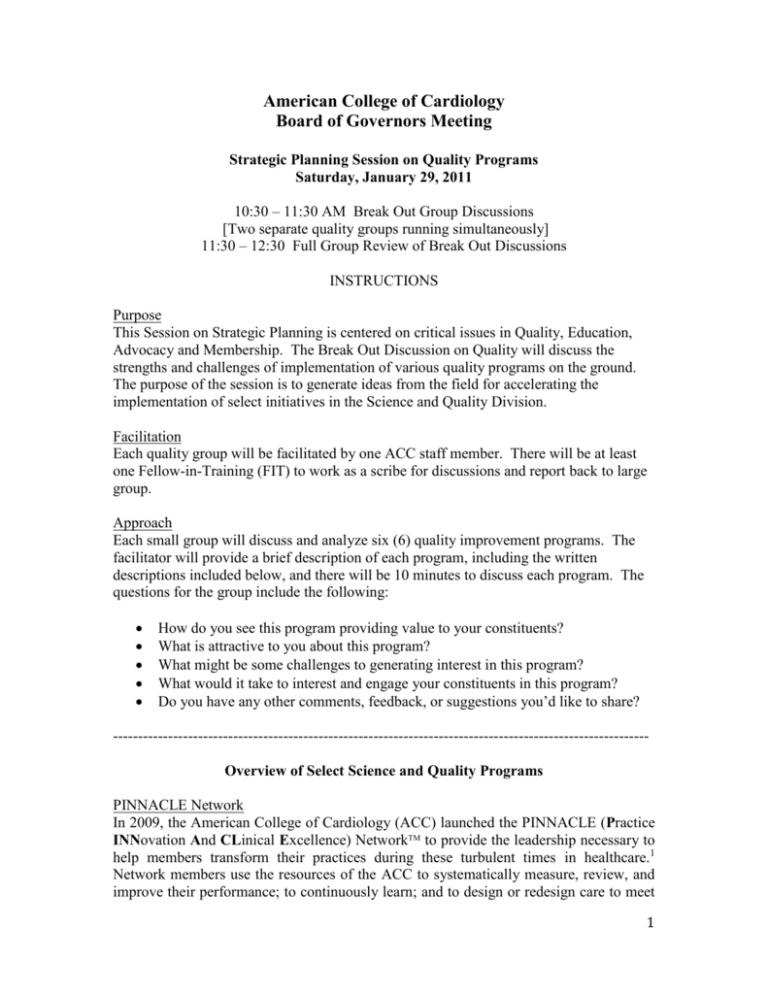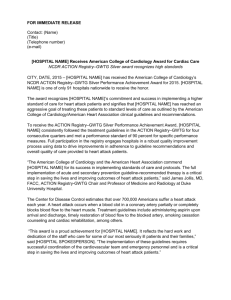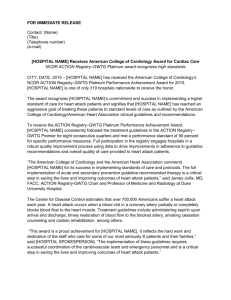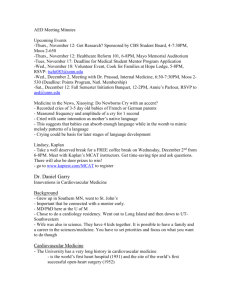The PINNACLE NetworkTM: Facilitating Quality of Care in Outpatient
advertisement

American College of Cardiology Board of Governors Meeting Strategic Planning Session on Quality Programs Saturday, January 29, 2011 10:30 – 11:30 AM Break Out Group Discussions [Two separate quality groups running simultaneously] 11:30 – 12:30 Full Group Review of Break Out Discussions INSTRUCTIONS Purpose This Session on Strategic Planning is centered on critical issues in Quality, Education, Advocacy and Membership. The Break Out Discussion on Quality will discuss the strengths and challenges of implementation of various quality programs on the ground. The purpose of the session is to generate ideas from the field for accelerating the implementation of select initiatives in the Science and Quality Division. Facilitation Each quality group will be facilitated by one ACC staff member. There will be at least one Fellow-in-Training (FIT) to work as a scribe for discussions and report back to large group. Approach Each small group will discuss and analyze six (6) quality improvement programs. The facilitator will provide a brief description of each program, including the written descriptions included below, and there will be 10 minutes to discuss each program. The questions for the group include the following: How do you see this program providing value to your constituents? What is attractive to you about this program? What might be some challenges to generating interest in this program? What would it take to interest and engage your constituents in this program? Do you have any other comments, feedback, or suggestions you’d like to share? ----------------------------------------------------------------------------------------------------------Overview of Select Science and Quality Programs PINNACLE Network In 2009, the American College of Cardiology (ACC) launched the PINNACLE (Practice INNovation And CLinical Excellence) NetworkTM to provide the leadership necessary to help members transform their practices during these turbulent times in healthcare.1 Network members use the resources of the ACC to systematically measure, review, and improve their performance; to continuously learn; and to design or redesign care to meet 1 the needs of their patients and the new realities of health care payment reform. The PINNACLE Network is comprised of three components. The PINNACLE RegistryTM is the nation’s largest cardiovascular ambulatory quality improvement registry. The PINNACLE Network Portfolio provides an organized set of programs, tools, and services for cardiovascular practices. And at its core is an interactive Community of Peers committed to delivering coordinated, efficient, safe, and effective cardiovascular care for their patients; and sharing their experience with others. Participants benefit from being part of a community of like-minded peers. These relationships are ideal for sharing best-practice information and for informally disseminating useful and practical information. In the very near future, several enhancements and additional Portfolio products will be available to PINNACLE Network participants through the ACC website, CardioSource.2 Soon to be added online discussion forums will encourage community-building through such topics as practice vitality strategies, preparing for health care reform, and addressing the implementation of EHRs. Primers and select videos will help the cardiovascular healthcare team in such topics as performance measures, ACC guidelines and AUC, QI and EHR. Financial primers will offer assistance in such areas as fee schedule analysis. Legal Issue Briefs will provide guidance in such areas as buying and selling medical practices and physician employment contracts. Over the course of the next year, monthly webinars will help inform and educate Network members on timely topics such as ACOs, payment models, team-based care, and the ICD-10 coding update. Case studies, live programs, and disease-specific clinical QI tool kits will also be provided as the year unfolds. PINNACLE Registry The PINNACLE Registry is one of five registries of the ACC’s NCDR® (National Cardiovascular Data Registry).3 The primary purpose of the PINNACLE Registry is facilitating improvement in outpatient cardiovascular care quality and, by extension, improving patient outcomes. The PINNACLE Registry captures clinical data of participating practices related to the outpatient care provided to patients with coronary artery disease (CAD), atrial fibrillation, heart failure and hypertension. Utilizing established guidelines and performance measures, the PINNACLE Registry was designed to drive care improvement by reducing inappropriate variations in care, eliminating gaps in care, and improving care coordination for patients with cardiovascular diseases. The Registry assists practices in understanding and improving care through the production and distribution of quarterly performance reports for data-submitting practices and physicians. These reports, covering all valid patient encounters, detail adherence to 25 cardiovascular clinical measures at the physician, location, and practice levels. They include practice performance for the individual practice compared to the national average for all practices in the registry, for the site locations within each practice compared with each other and with the practice average, as well as for individual physicians compared with each other and with the practice average. 2 PINNACLE Registry data collection is based in practices’ outpatient electronic health record (EHR) systems, allowing for data typically collected in EHR systems to automatically populate and match with required PINNACLE Registry data elements. This method vastly reduces duplicative data entry, minimizes workflow interruption, and provides maximum clinical value to the participating practices. In addition to QI applications, NCDR and PINNACLE Registry data are used by researchers and clinicians for novel scientific output, including submissions to peer-reviewed medical and academic journals. Hospital to Home (H2H): A National Quality Improvement Initiative With the onset of health care reform, health care practitioners face a major challenge: how to reduce 30-day readmissions for heart failure and acute myocardial infarction—or risk losing Medicare reimbursement for these admissions. To meet this challenge, practitioners need concrete steps to accomplish this reduction and tools to support patients in managing their care. The Hospital to Home (H2H) national quality improvement initiative, led by the American College of Cardiology and the Institute for Healthcare Improvement (IHI), is a national rallying point to reduce cardiovascularrelated hospital readmissions and improve the transition from inpatient to outpatient status for individuals hospitalized with cardiovascular disease. H2H is intentionally broad-based and inclusive, incorporating the viewpoints of patients and family caregivers, clinicians across the continuum of care, integrated health systems, communities, policy-makers and payers. This initiative provides an opportunity for us to achieve together what can't be accomplish alone. The H2H initiative is an effort to improve the transition from inpatient to outpatient status for individuals hospitalized with cardiovascular disease. FOCUS FOCUS4 is a national quality improvement initiative designed to help cardiovascular professionals best use Appropriate Use Criteria (AUC) and ultimately reduce inappropriate imaging. The Community is working on best practices in implementing AUC for CT, Stress and Resting Echo and RNI. The program’s resources are free and centralized in one place. They offer access to an AUC QI listserv, pocket cards, best practices, Webinars, and a performance improvement module. These resources can support a practice in evaluating AUC, as well as documenting QI activities for laboratory accreditation and maintenance of certification (MOC). In the coming year, additional tools will be added to FOCUS supporting additional AUC documents and point of care electronic decision support. These additional enhancements will be available on a subscription basis and can be packaged with PINNACLE Network membership once they are available. Lastly, updates on efforts by ACC to package these resources for health plans, the Centers for Medicaid and Medicare Services (CMS) and Accountable Care Organizations (ACO) in ways to be used in lieu of Radiology Benefit Managers will be posted on the FOCUS site. Health plan and ACO contracts to use FOCUS would alleviate practice administrative burdens and costs while providing participants with access to coming enhanced FOCUS resources. 3 CPIP Participants can benefit from lifelong educational and performance improvement activities through the Network. The Cardiology Practice Improvement Pathway (CPIP) is a practice-level performance improvement program designed specifically to enhance and instill quality in cardiovascular practice. The CPIP is approved through the American Board of Internal Medicine’s (ABIM) Approved Quality Improvement (AQI) Pathway and is eligible for 20 points towards the Self-Evaluation of Practice Performance requirement MOC. CPIP provides a platform for practices to evaluate themselves against a comprehensive measure set designed to support the delivery of cardiovascular care that achieves the six national quality aims identified by the Institute of Medicine (IOM): care should be safe, timely, effective, efficient, equitable, and patient-centered (STEEEP). The CPIP comprehensive measure set is currently organized within three domains--clinical, structural, and professional. CPIP offers practices opportunities to learn about their practice patterns at the group level and to understand how they measure up against the quality goals and targets established by their medical specialty society. Practices receive immediate feedback on their performance with recommendations for developing and implementing QI plans based on their results. Within three months of beginning the assessment phase (Stage A) of the pathway, practices complete data collection and submission requirements in order to attain their baseline performance. Practices will identify opportunities for improvement in the clinical domain and develop a QI plan. Practices will implement their QI plan over a 6-month period (Stage B). Within 3 months of completing Stage B, practices will re-measure their clinical performance to determine if the steps they have taken resulted in an improvement (Stage C). Quality Improvement Tools [Need a description here; perhaps we should title it BPQI and take that approach]. References 1. American College of Cardiology PINNACLE Network. Available at: http://www.pinnaclenetwork.org/ (accessed January 3, 2011). 2. American College of Cardiology: CardioSource. Available at: http://www.cardiosource.org/ (accessed January 3, 2011). 3. National Cardiovascular Data Registry. Available at: http://www.ncdr.com/webncdr/common/ (accessed January 3, 2011). 4 4. American College of Cardiology Imaging in FOCUS Available at: http://www.cardiosource.org/Science-And-Quality/Quality-Programs/Imaging-inFOCUS.aspx (accessed January 3, 2011). 5








